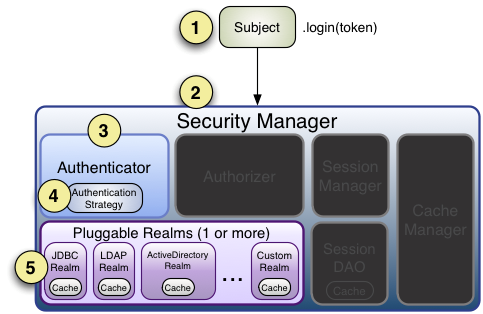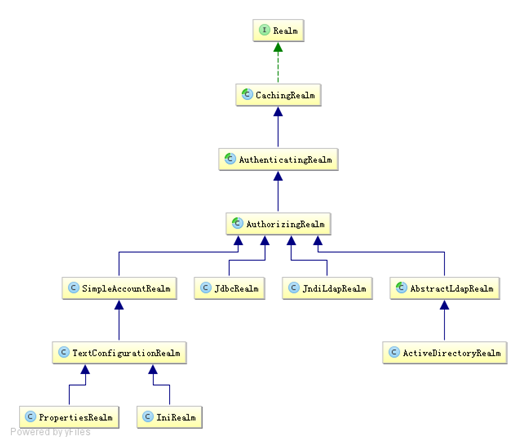身份验证,即在应用中谁能证明他就是他本人。一般提供如他们的身份ID一些标识信息来表明他就是他本人,如提供身份证,用户名/密码来证明。
在shiro中,用户需要提供principals (身份)和credentials(证明)给shiro,从而应用能验证用户身份:
principals:身份,即主体的标识属性,可以是任何东西,如用户名、邮箱等,唯一即可。一个主体可以有多个principals,但只有一个Primary principals,一般是用户名/密码/手机号。
credentials:证明/凭证,即只有主体知道的安全值,如密码/数字证书等。
最常见的principals和credentials组合就是用户名/密码了。接下来先进行一个基本的身份认证。
另外两个相关的概念是之前提到的Subject及Realm,分别是主体及验证主体的数据源.
2.2 环境准备
本文使用Maven构建,因此需要一点Maven知识。首先准备环境依赖:
<dependencies>
<dependency>
<groupId>junit</groupId>
<artifactId>junit</artifactId>
<version>4.9</version>
</dependency>
<dependency>
<groupId>commons-logging</groupId>
<artifactId>commons-logging</artifactId>
<version>1.1.3</version>
</dependency>
<dependency>
<groupId>org.apache.shiro</groupId>
<artifactId>shiro-core</artifactId>
<version>1.2.2</version>
</dependency>
</dependencies>
添加junit、common-logging及shiro-core依赖即可。
2.3 登录/退出
1、首先准备一些用户身份/凭据(shiro.ini)
[users] zhang=123 wang=123
此处使用ini配置文件,通过[users]指定了两个主体:zhang/123、wang/123。
2、测试用例(com.github.zhangkaitao.shiro.chapter2.LoginLogoutTest)
@Test public void testHelloworld() { //1、获取SecurityManager工厂,此处使用Ini配置文件初始化SecurityManager Factory<org.apache.shiro.mgt.SecurityManager> factory = new IniSecurityManagerFactory("classpath:shiro.ini"); //2、得到SecurityManager实例 并绑定给SecurityUtils org.apache.shiro.mgt.SecurityManager securityManager = factory.getInstance(); SecurityUtils.setSecurityManager(securityManager); //3、得到Subject及创建用户名/密码身份验证Token(即用户身份/凭证) Subject subject = SecurityUtils.getSubject(); UsernamePasswordToken token = new UsernamePasswordToken("zhang", "123"); try { //4、登录,即身份验证 subject.login(token); } catch (AuthenticationException e) { //5、身份验证失败 } Assert.assertEquals(true, subject.isAuthenticated()); //断言用户已经登录 //6、退出 subject.logout(); }
2.1、首先通过new IniSecurityManagerFactory并指定一个ini配置文件来创建一个SecurityManager工厂;
2.2、接着获取SecurityManager并绑定到SecurityUtils,这是一个全局设置,设置一次即可;
2.3、通过SecurityUtils得到Subject,其会自动绑定到当前线程;如果在web环境在请求结束时需要解除绑定;然后获取身份验证的Token,如用户名/密码;
2.4、调用subject.login方法进行登录,其会自动委托给SecurityManager.login方法进行登录;
2.5、如果身份验证失败请捕获AuthenticationException或其子类,常见的如: DisabledAccountException(禁用的帐号)、LockedAccountException(锁定的帐号)、UnknownAccountException(错误的帐号)、ExcessiveAttemptsException(登录失败次数过多)、IncorrectCredentialsException (错误的凭证)、ExpiredCredentialsException(过期的凭证)等,具体请查看其继承关系;对于页面的错误消息展示,最好使用如“用户名/密码错误”而不是“用户名错误”/“密码错误”,防止一些恶意用户非法扫描帐号库;
2.6、最后可以调用subject.logout退出,其会自动委托给SecurityManager.logout方法退出.
从如上代码可总结出身份验证的步骤:
1、收集用户身份/凭证,即如用户名/密码;
2、调用Subject.login进行登录,如果失败将得到相应的AuthenticationException异常,根据异常提示用户错误信息;否则登录成功;
3、最后调用Subject.logout进行退出操作。
如上测试的几个问题:
1、用户名/密码硬编码在ini配置文件,以后需要改成如数据库存储,且密码需要加密存储;
2、用户身份Token可能不仅仅是用户名/密码,也可能还有其他的,如登录时允许用户名/邮箱/手机号同时登录
2.4 身份认证流程

流程如下:
1、首先调用Subject.login(token)进行登录,其会自动委托给Security Manager,调用之前必须通过SecurityUtils. setSecurityManager()设置;
2、SecurityManager负责真正的身份验证逻辑;它会委托给Authenticator进行身份验证;
3、Authenticator才是真正的身份验证者,Shiro API中核心的身份认证入口点,此处可以自定义插入自己的实现;
4、Authenticator可能会委托给相应的AuthenticationStrategy进行多Realm身份验证,默认ModularRealmAuthenticator会调用AuthenticationStrategy进行多Realm身份验证;
5、Authenticator会把相应的token传入Realm,从Realm获取身份验证信息,如果没有返回/抛出异常表示身份验证失败了。此处可以配置多个Realm,将按照相应的顺序及策略进行访问。
2.5 Realm
Realm:域,Shiro从从Realm获取安全数据(如用户、角色、权限),就是说SecurityManager要验证用户身份,那么它需要从Realm获取相应的用户进行比较以确定用户身份是否合法;也需要从Realm得到用户相应的角色/权限进行验证用户是否能进行操作;可以把Realm看成DataSource,即安全数据源。如我们之前的ini配置方式将使用org.apache.shiro.realm.text.IniRealm。
org.apache.shiro.realm.Realm接口如下:
String getName(); //返回一个唯一的Realm名字 boolean supports(AuthenticationToken token); //判断此Realm是否支持此Token AuthenticationInfo getAuthenticationInfo(AuthenticationToken token) throws AuthenticationException; //根据Token获取认证信息
单Realm配置
1、自定义Realm实现(com.github.zhangkaitao.shiro.chapter2.realm.MyRealm1):
public class MyRealm1 implements Realm { @Override public String getName() { return "myrealm1"; } @Override public boolean supports(AuthenticationToken token) { //仅支持UsernamePasswordToken类型的Token return token instanceof UsernamePasswordToken; } @Override public AuthenticationInfo getAuthenticationInfo(AuthenticationToken token) throws AuthenticationException { String username = (String)token.getPrincipal(); //得到用户名 String password = new String((char[])token.getCredentials()); //得到密码 if(!"zhang".equals(username)) { throw new UnknownAccountException(); //如果用户名错误 } if(!"123".equals(password)) { throw new IncorrectCredentialsException(); //如果密码错误 } //如果身份认证验证成功,返回一个AuthenticationInfo实现; return new SimpleAuthenticationInfo(username, password, getName()); } }
2、ini配置文件指定自定义Realm实现(shiro-realm.ini)
#声明一个realm myRealm1=com.github.zhangkaitao.shiro.chapter2.realm.MyRealm1 #指定securityManager的realms实现 securityManager.realms=$myRealm1
通过$name来引入之前的realm定义
3、测试用例请参考com.github.zhangkaitao.shiro.chapter2.LoginLogoutTest的testCustomRealm测试方法,只需要把之前的shiro.ini配置文件改成shiro-realm.ini即可。
多Realm配置
1、ini配置文件(shiro-multi-realm.ini)
#声明一个realm myRealm1=com.github.zhangkaitao.shiro.chapter2.realm.MyRealm1 myRealm2=com.github.zhangkaitao.shiro.chapter2.realm.MyRealm2 #指定securityManager的realms实现 securityManager.realms=$myRealm1,$myRealm2
securityManager会按照realms指定的顺序进行身份认证。此处我们使用显示指定顺序的方式指定了Realm的顺序,如果删除“securityManager.realms=$myRealm1,$myRealm2”,那么securityManager会按照realm声明的顺序进行使用(即无需设置realms属性,其会自动发现),当我们显示指定realm后,其他没有指定realm将被忽略,如“securityManager.realms=$myRealm1”,那么myRealm2不会被自动设置进去。
2、测试用例请参考com.github.zhangkaitao.shiro.chapter2.LoginLogoutTest的testCustomMultiRealm测试方法
Shiro默认提供的Realm

以后一般继承AuthorizingRealm(授权)即可;其继承了AuthenticatingRealm(即身份验证),而且也间接继承了CachingRealm(带有缓存实现)。其中主要默认实现如下:
org.apache.shiro.realm.text.IniRealm:[users]部分指定用户名/密码及其角色;[roles]部分指定角色即权限信息;
org.apache.shiro.realm.text.PropertiesRealm: user.username=password,role1,role2指定用户名/密码及其角色;role.role1=permission1,permission2指定角色及权限信息;
org.apache.shiro.realm.jdbc.JdbcRealm:通过sql查询相应的信息,如“select password from users where username = ?”获取用户密码,“select password, password_salt from users where username = ?”获取用户密码及盐;“select role_name from user_roles where username = ?”获取用户角色;“select permission from roles_permissions where role_name = ?”获取角色对应的权限信息;也可以调用相应的api进行自定义sql;
JDBC Realm使用
1、数据库及依赖
<dependency>
<groupId>mysql</groupId>
<artifactId>mysql-connector-java</artifactId>
<version>5.1.25</version>
</dependency>
<dependency>
<groupId>com.alibaba</groupId>
<artifactId>druid</artifactId>
<version>0.2.23</version>
</dependency>
本文将使用mysql数据库及druid连接池;
2、到数据库shiro下建三张表:users(用户名/密码)、user_roles(用户/角色)、roles_permissions(角色/权限),具体请参照shiro-example-chapter2/sql/shiro.sql;并添加一个用户记录,用户名/密码为zhang/123;
3、ini配置(shiro-jdbc-realm.ini)
jdbcRealm=org.apache.shiro.realm.jdbc.JdbcRealm dataSource=com.alibaba.druid.pool.DruidDataSource dataSource.driverClassName=com.mysql.jdbc.Driver dataSource.url=jdbc:mysql://localhost:3306/shiro dataSource.username=root #dataSource.password= jdbcRealm.dataSource=$dataSource securityManager.realms=$jdbcRealm
1、变量名=全限定类名会自动创建一个类实例
2、变量名.属性=值 自动调用相应的setter方法进行赋值
3、$变量名 引用之前的一个对象实例
4、测试代码请参照com.github.zhangkaitao.shiro.chapter2.LoginLogoutTest的testJDBCRealm方法,和之前的没什么区别。
2.6 Authenticator及AuthenticationStrategy
Authenticator的职责是验证用户帐号,是Shiro API中身份验证核心的入口点:
public AuthenticationInfo authenticate(AuthenticationToken authenticationToken) throws AuthenticationException;
如果验证成功,将返回AuthenticationInfo验证信息;此信息中包含了身份及凭证;如果验证失败将抛出相应的AuthenticationException实现。
SecurityManager接口继承了Authenticator,另外还有一个ModularRealmAuthenticator实现,其委托给多个Realm进行验证,验证规则通过AuthenticationStrategy接口指定,默认提供的实现:
FirstSuccessfulStrategy:只要有一个Realm验证成功即可,只返回第一个Realm身份验证成功的认证信息,其他的忽略;
AtLeastOneSuccessfulStrategy:只要有一个Realm验证成功即可,和FirstSuccessfulStrategy不同,返回所有Realm身份验证成功的认证信息;
AllSuccessfulStrategy:所有Realm验证成功才算成功,且返回所有Realm身份验证成功的认证信息,如果有一个失败就失败了。
ModularRealmAuthenticator默认使用AtLeastOneSuccessfulStrategy策略。
假设我们有三个realm:
myRealm1: 用户名/密码为zhang/123时成功,且返回身份/凭据为zhang/123;
myRealm2: 用户名/密码为wang/123时成功,且返回身份/凭据为wang/123;
myRealm3: 用户名/密码为zhang/123时成功,且返回身份/凭据为zhang@163.com/123,和myRealm1不同的是返回时的身份变了;
1、ini配置文件(shiro-authenticator-all-success.ini)
#指定securityManager的authenticator实现 authenticator=org.apache.shiro.authc.pam.ModularRealmAuthenticator securityManager.authenticator=$authenticator #指定securityManager.authenticator的authenticationStrategy allSuccessfulStrategy=org.apache.shiro.authc.pam.AllSuccessfulStrategy securityManager.authenticator.authenticationStrategy=$allSuccessfulStrategy
myRealm1=com.github.zhangkaitao.shiro.chapter2.realm.MyRealm1 myRealm2=com.github.zhangkaitao.shiro.chapter2.realm.MyRealm2 myRealm3=com.github.zhangkaitao.shiro.chapter2.realm.MyRealm3 securityManager.realms=$myRealm1,$myRealm3
2、测试代码(com.github.zhangkaitao.shiro.chapter2.AuthenticatorTest)
2.1、首先通用化登录逻辑
private void login(String configFile) { //1、获取SecurityManager工厂,此处使用Ini配置文件初始化SecurityManager Factory<org.apache.shiro.mgt.SecurityManager> factory = new IniSecurityManagerFactory(configFile); //2、得到SecurityManager实例 并绑定给SecurityUtils org.apache.shiro.mgt.SecurityManager securityManager = factory.getInstance(); SecurityUtils.setSecurityManager(securityManager); //3、得到Subject及创建用户名/密码身份验证Token(即用户身份/凭证) Subject subject = SecurityUtils.getSubject(); UsernamePasswordToken token = new UsernamePasswordToken("zhang", "123"); subject.login(token); }
2.2、测试AllSuccessfulStrategy成功:
@Test public void testAllSuccessfulStrategyWithSuccess() { login("classpath:shiro-authenticator-all-success.ini"); Subject subject = SecurityUtils.getSubject(); //得到一个身份集合,其包含了Realm验证成功的身份信息 PrincipalCollection principalCollection = subject.getPrincipals(); Assert.assertEquals(2, principalCollection.asList().size()); }
即PrincipalCollection包含了zhang和zhang@163.com身份信息。
2.3、测试AllSuccessfulStrategy失败:
@Test(expected = UnknownAccountException.class) public void testAllSuccessfulStrategyWithFail() { login("classpath:shiro-authenticator-all-fail.ini"); Subject subject = SecurityUtils.getSubject(); }
shiro-authenticator-all-fail.ini与shiro-authenticator-all-success.ini不同的配置是使用了securityManager.realms=$myRealm1,$myRealm2;即myRealm验证失败。
对于AtLeastOneSuccessfulStrategy和FirstSuccessfulStrategy的区别,请参照testAtLeastOneSuccessfulStrategyWithSuccess和testFirstOneSuccessfulStrategyWithSuccess测试方法。唯一不同点一个是返回所有验证成功的Realm的认证信息;另一个是只返回第一个验证成功的Realm的认证信息。
自定义AuthenticationStrategy实现,首先看其API:
//在所有Realm验证之前调用 AuthenticationInfo beforeAllAttempts( Collection<? extends Realm> realms, AuthenticationToken token) throws AuthenticationException; //在每个Realm之前调用 AuthenticationInfo beforeAttempt( Realm realm, AuthenticationToken token, AuthenticationInfo aggregate) throws AuthenticationException; //在每个Realm之后调用 AuthenticationInfo afterAttempt( Realm realm, AuthenticationToken token, AuthenticationInfo singleRealmInfo, AuthenticationInfo aggregateInfo, Throwable t) throws AuthenticationException; //在所有Realm之后调用 AuthenticationInfo afterAllAttempts( AuthenticationToken token, AuthenticationInfo aggregate) throws AuthenticationException;
因为每个AuthenticationStrategy实例都是无状态的,所有每次都通过接口将相应的认证信息传入下一次流程;通过如上接口可以进行如合并/返回第一个验证成功的认证信息。
自定义实现时一般继承org.apache.shiro.authc.pam.AbstractAuthenticationStrategy即可,具体可以参考代码com.github.zhangkaitao.shiro.chapter2.authenticator.strategy包下OnlyOneAuthenticatorStrategy 和AtLeastTwoAuthenticatorStrategy。
到此基本的身份验证就搞定了,对于AuthenticationToken 、AuthenticationInfo和Realm的详细使用后续章节再陆续介绍。
示例源代码:https://github.com/zhangkaitao/shiro-example;
转自http://jinnianshilongnian.iteye.com/blog/2019547.强烈推荐此博主的博客